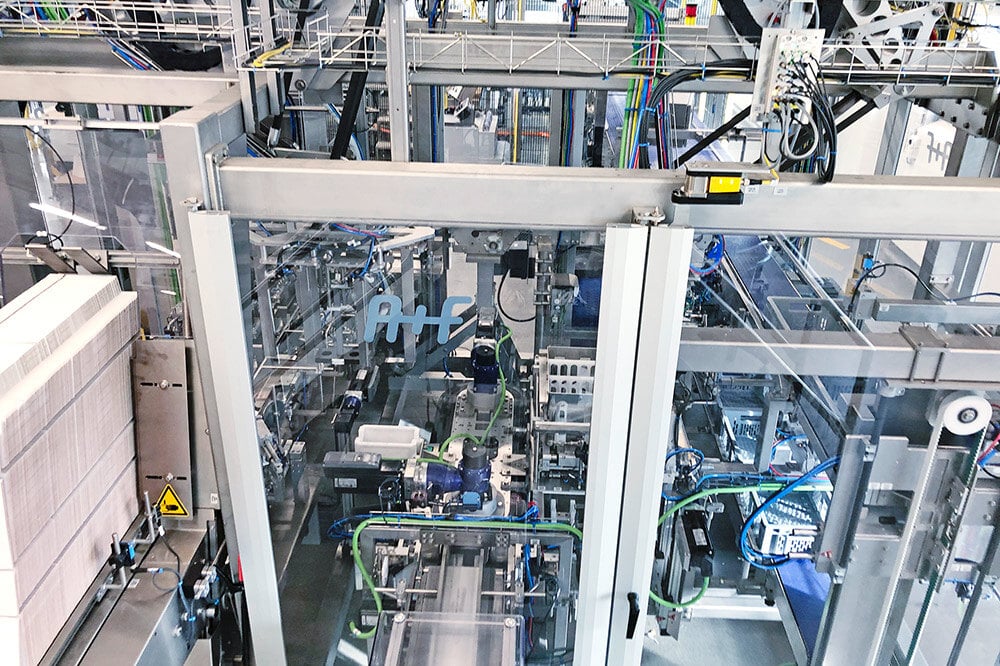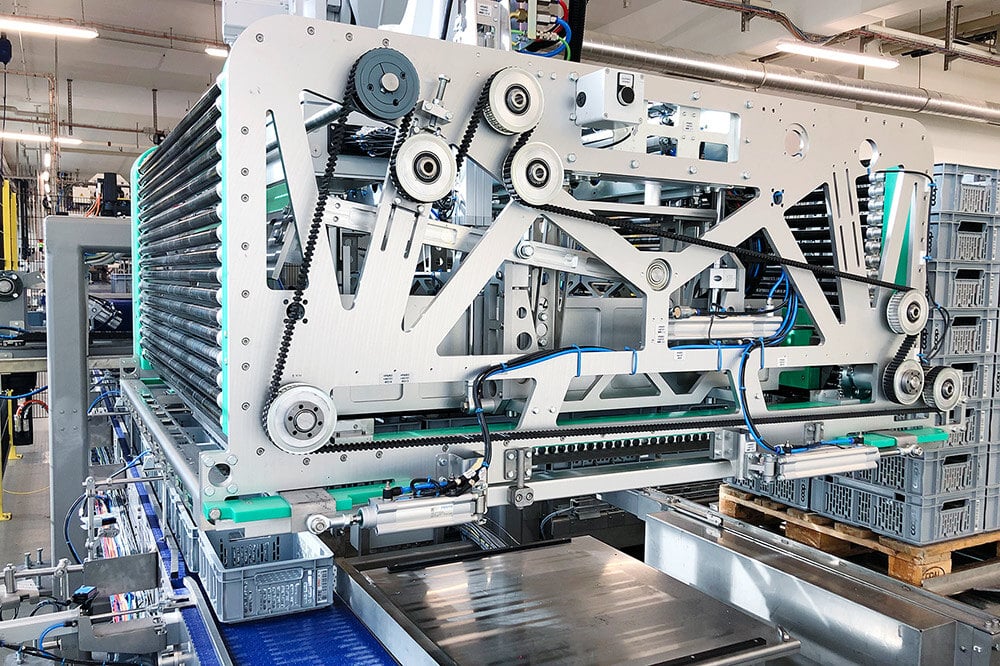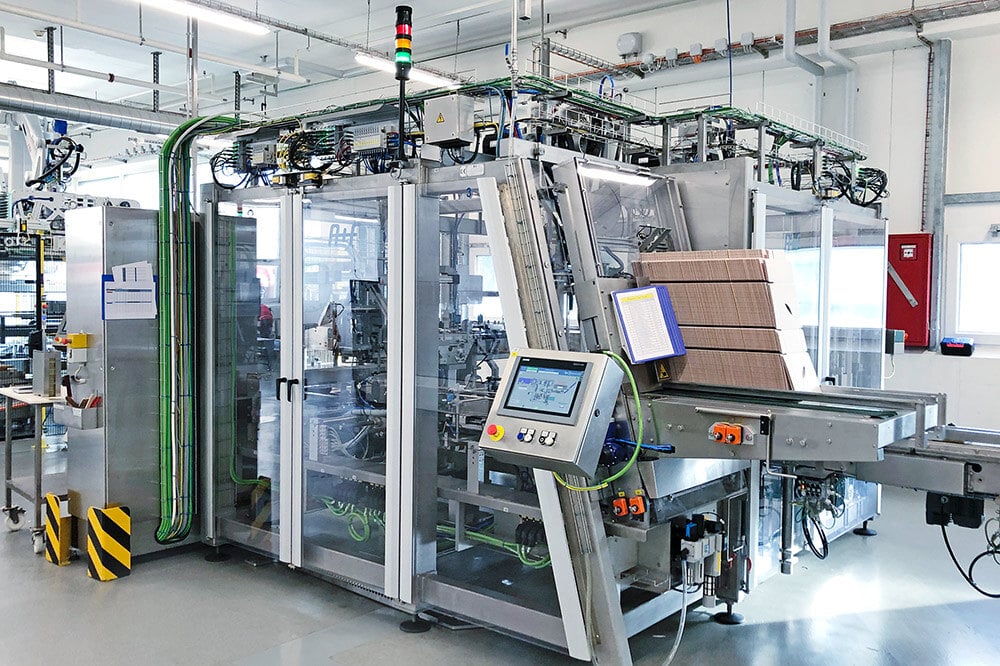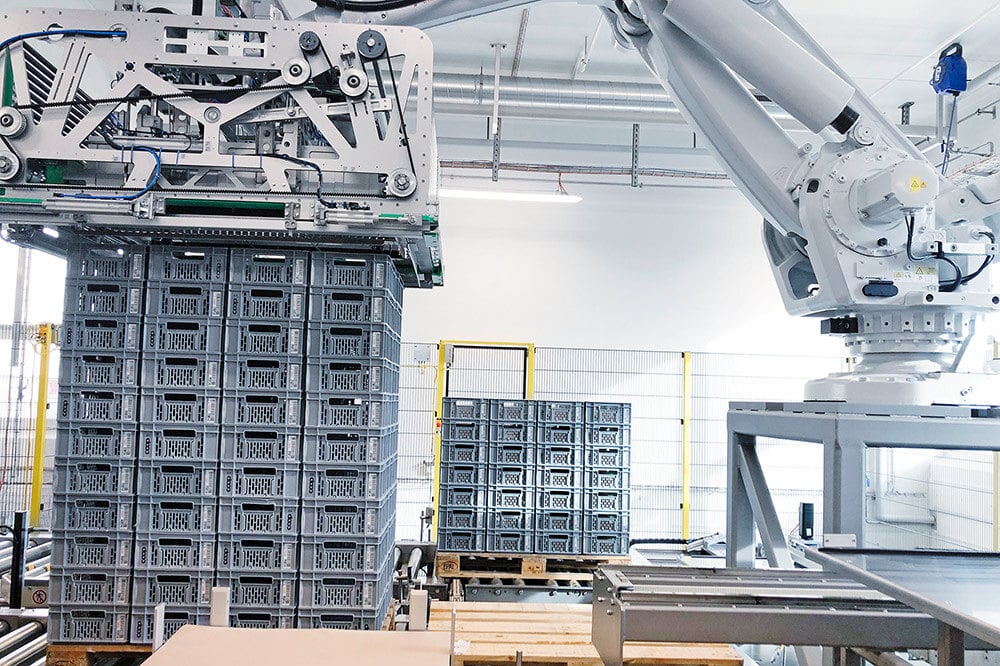
Compact, flexible, powerful
Emmi AG, Switzerland, invests in state-of-the-art packing and palletizing solution for thermoformed trays
Raclette understandably has a clear seasonal peak. But demand is also stable outside the cold season. So stable, in fact, that the Swiss Emmi Group invested in a state-of-the-art raclette slicing line last year. The key components are a combi packer for wrap-around and plastic crates and a multifunctional robot palletizer.
Switzerland, dairy, Emmi - it's like the owls and Athens. Emmi is the largest milk processor in Switzerland with an international presence, well ahead of its competitors. In 2023, the Emmi Group generated sales of CHF 4.232 billion, a slight increase of 0.3 percent on the previous record year of 2022. Organic growth amounted to 3.5 percent. Strategically important markets such as the US, Brazil and Chile, as well as Switzerland, are enjoying above-average success.

The case packer inserts the thermoformed trays into wrap-around cartons (left) and into two returnable plastic containers (right).
Also very popular with cheese burgers
The cheese segment, including the famous raclette cheese, makes a not inconsiderable contribution to this. But isn't raclette synonymous with cold, snow and Christmas? Not at all, as Martin Küttel, the responsible value stream manager at Emmi, explains: "Demand is certainly about three times higher in the cold months. But demand for raclette is also stable elsewhere. The cheese is very popular in cheese burgers, for example." Emmi therefore decided to abandon two existing raclette slicing lines and build a completely new one at the Emmen site. With clearly defined investment goals. "Firstly, we wanted a significantly higher output. Secondly, we wanted automation. This was previously only available for cardboard packaging. We processed the reusable containers typical of Switzerland manually, as did the entire palletizing process," summarizes Küttel.
Wrap-around as an attractive alternative
There were three decisive reasons for the solution implemented in 2023, as Küttel points out: "We actually wanted a two-part carton again. But then we were given the option of a wrap-around, which saves us costs." According to Küttel, the second main reason was that Emmi can now process both the carton and the reusable pack on just one machine. "All other suppliers would have needed two machines for this, which would have taken up more space, of course." Thirdly: "Our current palletizer performs all its tasks with just a single gripper head. Other suppliers would also have needed twice as many," explains Küttel.
New design from proven modules
Specifically, a ModuLine case packer for thermoformed trays in wrap-around cartons and two returnable plastic packs were ordered. This packer is a new development from existing and proven machine modules - and is currently still a one-off. A robot palletizer and depalletizer for returnable packs, wrap-around cartons and the intermediate inserts, the necessary conveyor technology for returnable packs, wrap-arounds and pallets as well as a turntable wrapper and a pallet labeler were also added. The entire package was handled on a turnkey basis.

All palletizing and depalletizing tasks, including the application of intermediate layers, are performed by just one gripper head.
The packing and palletizing unit was successfully approved in December 2023. Since then, it has proven itself in daily practical use with the following processes: The aligned thermoformed trays are taken from the customer's conveyor belt with the short side leading and the decor on top in 1 lane and conveyed into a cavity and stacked. Six cavities are attached to a cell chain arranged in a square with a two-pull mechanism using a quick-release fastener. Once the cavities have been filled, they are cycled to the 2-axis gantry and lifted. The 2-axis gantry lifts the stack by means of a gripper and, depending on the program preselection, places it in the tray pre-folded from the flat blank or in one of the two reusable containers. It is important that the packaging parameters length and width do not change.
Grammage defines packaging height
In contrast, the height of the packaging is variable due to the desired grammage. Küttel explains: "The tray packaging type is a very volatile market. There were already new grammages in demand during the course of the project." This meant a considerable programming effort in order to ensure the necessary flexibility for the packer, also with a view to the future. With success: "We can now make the necessary adjustments here on the machine," says Küttel.
The trays are then glued around the product with hot glue and then discharged crosswise. The filled reusable containers are also transported to the palletizing area via the conveyor system. The highest possible energy efficiency was ensured in all areas, for example through a closed servo drive system in the axis system or by lowering the temperature of the gluing unit when not in use.

The wrap-around solution replaces a two-part box: "This saves us costs."
Everything with one palletizing head
In the robot palletizing cell, both the empty returnable packs are depalletized from the carrier pallets and fed to the packer and the full returnable packs and wrap-around cartons coming from the packer are palletized and intermediate layers are inserted. With a single palletizing head. "We have three different secondary packs, two different pallet types and a layer pad for the cartons. And limited space. The robot saves space and, with its multifunctional gripper head, is much more flexible than other palletizing cells," explains Küttel.
The palletizing cell was integrated into the higher-level ERP system. This sends the required data for the respective palletizing order to the robot, which then adjusts itself automatically. Palletizing is therefore controlled by the ERP system. Just like the application of the required pallet label. Manual data collection at the palletizer is not necessary. Another software tool is the so-called condition monitoring. This program generates statistics, documents any system errors that occur and allows system analysis via the Internet.

The robot palletizer also feeds the returnable packs to the packer.
"We are now in a really good position"
"We're looking forward to the next peak season with confidence. We are now really well positioned with our new raclette line," summarizes Küttel. An important tool in this successful project management was construction site management with LOP 4.0. LOP 4.0 is a cloud-based system that can be accessed by all project participants. This digital platform maps the project status during the construction site phase, from delivery to commissioning, with the greatest possible transparency. LOP 4.0 is also an open communication and documentation platform. Each project partner can, for example, upload photos or videos, post next steps for discussion or prioritize individual points. This ensures that the status of all project components is always up-to-date and clearly understandable. Interactions on the further course of the project are immediately visible. This reduces friction and coordination losses and leads to a high degree of predictability - and customer satisfaction. And as the saying goes: only a satisfied customer will place the next order. This was obviously the case at Emmi - another packer and carton erector have already been ordered from the EOL Group.

